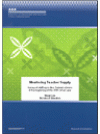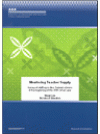The 2010 Monitoring Teacher Supply report provides the Ministry with a snapshot of the number of entitlement staffing vacancies and re-advertised vacancies in schools at the start of Term 1, how these vacancies are being covered and, in the case of secondary schools, in what subject areas pressure points are occurring.
Key Results
The Research Division, Ministry of Education conducts the survey of staffing annually to provide the Ministry with a snapshot of the number of entitlement staffing vacancies1 and re-advertised vacancies in schools at the start of Term 1. In 2010, the survey was completed by 95 percent of all state and state-integrated schools.
Results from this year’s survey showed that as a proportion of all entitlement positions, staffing vacancies in New Zealand schools at the beginning of the school year have halved since the start of the 2009 school year (from 0.8% in 2009 to 0.4% in 2010). This decrease in staffing vacancies is also reflected in a notable drop in the number of FTTE (Full-Time Teacher Equivalent) vacancies from 329.5 in 2009 to 185.6 in 2010. The significant decline in job vacancies in New Zealand schools is not unexpected given national trends indicating a decline in vacancies across a number of sectors as a result of the 2008/09 economic recession.
Consistent with the results presented in previous years’ reports, the subject areas with the highest number of vacancies in secondary schools were English, technology and mathematics and statistics.
Re-advertised positions in schools are considered to be an indication of ‘hard-to-staff’ positions. In 2010, one-third (33%) of all entitlement vacancies at the beginning of Term 1 had been re-advertised. These re-advertised vacancies represented 0.1 percent of all FTTE entitlement positions, a considerable decrease from 0.3 percent in 2009.
Consistent with trends identified in previous reports, vacancies and re-advertised positions were greatest in schools in rural areas (population <1,000), schools with the highest proportion of Māori students on their roll (relative to other schools) and low decile schools (deciles 1-3).
The survey also examined other sources of teacher supply for New Zealand schools, including the recruitment of first and second year (beginning) teachers. Just over half (55%) of primary schools and nearly three-quarters (84%) of secondary schools had first and/or second year beginning teachers on their staff in 2010. First and second year beginning teachers comprised 7.8 percent of the teaching population in primary schools and 6.6 percent of the teaching population in secondary schools.


